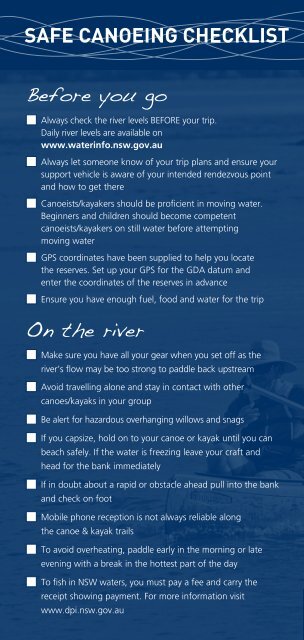Tumut River Canoe and Kayak Trail - Land
Tumut River Canoe and Kayak Trail - Land
Tumut River Canoe and Kayak Trail - Land
Create successful ePaper yourself
Turn your PDF publications into a flip-book with our unique Google optimized e-Paper software.
SAFE CAnOEinG CHECKLiST<br />
Before you go<br />
Always check the river levels BEFORE your trip.<br />
Daily river levels are available on<br />
www.waterinfo.nsw.gov.au<br />
Always let someone know of your trip plans <strong>and</strong> ensure your<br />
support vehicle is aware of your intended rendezvous point<br />
<strong>and</strong> how to get there<br />
<strong>Canoe</strong>ists/kayakers should be proficient in moving water.<br />
Beginners <strong>and</strong> children should become competent<br />
canoeists/kayakers on still water before attempting<br />
moving water<br />
GPS coordinates have been supplied to help you locate<br />
the reserves. Set up your GPS for the GDA datum <strong>and</strong><br />
enter the coordinates of the reserves in advance<br />
Ensure you have enough fuel, food <strong>and</strong> water for the trip<br />
On the river<br />
Make sure you have all your gear when you set off as the<br />
river’s flow may be too strong to paddle back upstream<br />
Avoid travelling alone <strong>and</strong> stay in contact with other<br />
canoes/kayaks in your group<br />
Be alert for hazardous overhanging willows <strong>and</strong> snags<br />
If you capsize, hold on to your canoe or kayak until you can<br />
beach safely. If the water is freezing leave your craft <strong>and</strong><br />
head for the bank immediately<br />
If in doubt about a rapid or obstacle ahead pull into the bank<br />
<strong>and</strong> check on foot<br />
Mobile phone reception is not always reliable along<br />
the canoe & kayak trails<br />
To avoid overheating, paddle early in the morning or late<br />
evening with a break in the hottest part of the day<br />
To fish in NSW waters, you must pay a fee <strong>and</strong> carry the<br />
receipt showing payment. For more information visit<br />
www.dpi.nsw.gov.au<br />
Safety gear<br />
A high visibility Personal Floatation Device - Type 2 with a<br />
whistle attached should be worn at all times on the water<br />
Hat <strong>and</strong> sunscreen<br />
Map, compass <strong>and</strong> GPS<br />
Spare paddle <strong>and</strong> repair kit<br />
Adequate drinking water <strong>and</strong> food for 5-8 hrs<br />
A first-aid kit <strong>and</strong> basic knowledge of CPR<br />
Waterproof containers for food <strong>and</strong> warm/dry clothing<br />
Appropriate footwear for water <strong>and</strong> rocks<br />
All canoes/kayaks should have fixed buoyancy with securing<br />
loops at each end<br />
A rope or throw line should be carried for rescue purposes<br />
At the campsite<br />
Practice low impact camping – take out what you take in<br />
Do not drink the river water without boiling or treating it.<br />
Carry adequate supplies of drinking water with you<br />
Light fires in fire places provided <strong>and</strong> extinguish completely<br />
before leaving. Observe any fire bans that are in place<br />
Bury your waste at least 50 m from the river if there are<br />
no toilets<br />
Do not interfere with vegetation, gates, fences or stock<br />
Do not use soaps or detergents in the river<br />
Respect other canoeists/kayakers <strong>and</strong> campers<br />
<strong>Canoe</strong> & kayak trail is published by<br />
nSW L<strong>and</strong> <strong>and</strong> Property Management Authority<br />
This booklet is designed as a reference guide only <strong>and</strong> is not to be<br />
used as a teaching aid. <strong>Canoe</strong>ists/kayakers use the trail at their<br />
own risk.

















